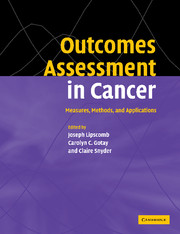Book contents
- Frontmatter
- Contents
- List of contributors
- Acknowledgments
- 1 Introduction to Outcomes Assessment in Cancer
- Health-related quality of life in cancer: general concepts and generic measures
- Assessing health-related quality of life during treatment
- Assessing health-related quality of life across the cancer continuum
- Measuring the experience and needs of cancer patients and caregivers
- Methodological considerations in applications to cancer outcomes research
- Modern psychometric theory in cancer outcomes research
- Assessing the economic impact of cancer
- 24 On the definition and measurement of the economic burden of cancer
- 25 Cost-effectiveness analysis in cancer: toward an iterative framework for integration of evidence from trials and models
- Research and policy implications
- Invited papers
- Index
- References
25 - Cost-effectiveness analysis in cancer: toward an iterative framework for integration of evidence from trials and models
Published online by Cambridge University Press: 18 December 2009
- Frontmatter
- Contents
- List of contributors
- Acknowledgments
- 1 Introduction to Outcomes Assessment in Cancer
- Health-related quality of life in cancer: general concepts and generic measures
- Assessing health-related quality of life during treatment
- Assessing health-related quality of life across the cancer continuum
- Measuring the experience and needs of cancer patients and caregivers
- Methodological considerations in applications to cancer outcomes research
- Modern psychometric theory in cancer outcomes research
- Assessing the economic impact of cancer
- 24 On the definition and measurement of the economic burden of cancer
- 25 Cost-effectiveness analysis in cancer: toward an iterative framework for integration of evidence from trials and models
- Research and policy implications
- Invited papers
- Index
- References
Summary
Introduction
Cost-effectiveness analysis is now an integral part of technology assessment and addresses the question of whether a new treatment or diagnostic intervention offers good value for money. Economic evaluation has been most prominent and formalized in the context of public-payer reimbursement of new medicines. For example, the national Pharmaceutical Benefits Scheme in Australia and the Ontario Drug Benefit Plan in Canada both require economic evidence from manufacturers in support of new submissions for formulary listing., In the UK, the National Institute of Clinical Excellence (NICE) uses economic evidence in setting guidance for the use of new technologies in the National Health Service. In the USA, the Public Health Service has issued influential guidelines in how health care cost-effectiveness studies should be conducted.
Cancer is a leading cause of death and disability, and advances in diagnosis and treatment often come at a high price that generates economic scrutiny and policy debate. For example, in their recent initial evaluation of a group of drugs known as taxanes (e.g., paclitaxel and docetaxel) for the British National Health Service, NICE raised doubts about their cost effectiveness, which led to appeals from manufacturers, lobbying from patient groups, and intense media coverage. Many other examples exist, covering the range from cancer screening (e.g., mammography for women between 40 and 50 years), cancer diagnosis (PET scanning for staging of lung cancer), and cancer treatment (e.g., Herceptin® for metastatic breast cancer or surgery for prostate cancer).
- Type
- Chapter
- Information
- Outcomes Assessment in CancerMeasures, Methods and Applications, pp. 503 - 521Publisher: Cambridge University PressPrint publication year: 2004
References
- 1
- Cited by



